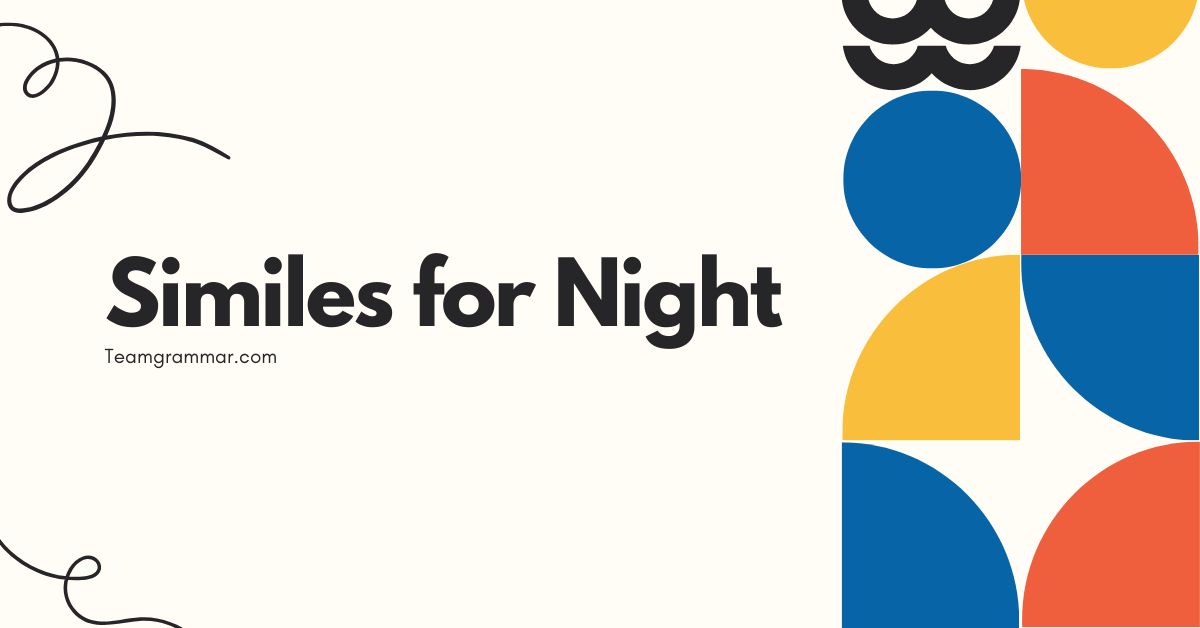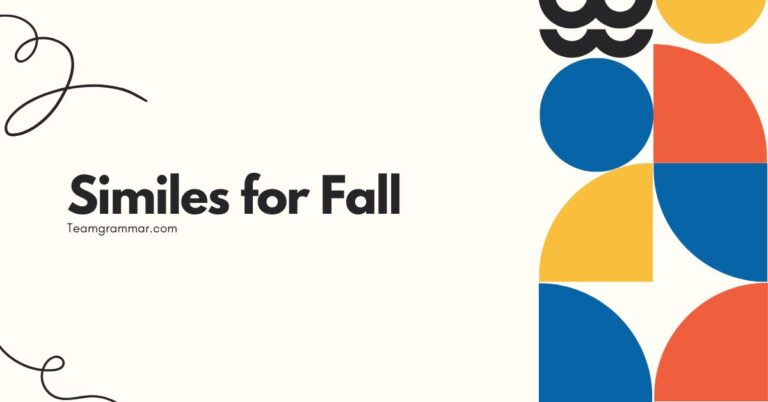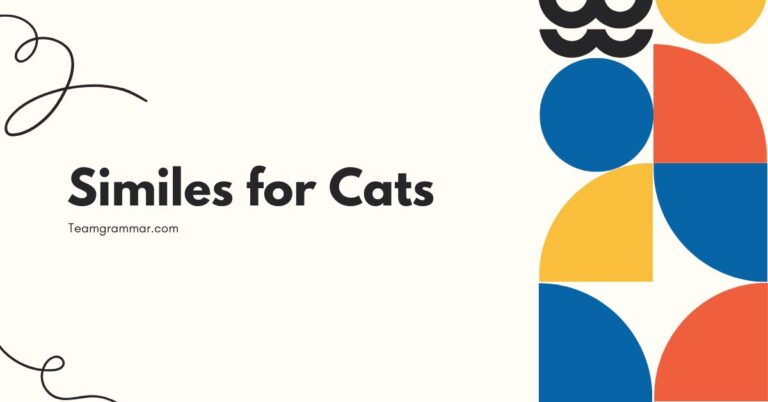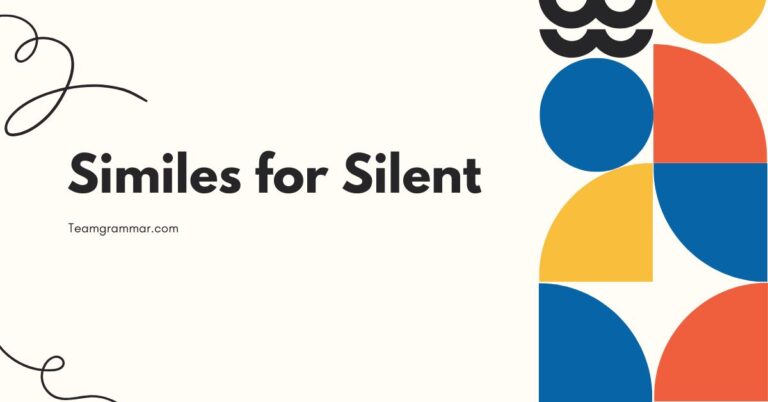49 Similes for Night: Mastering Figurative Language
Understanding similes is crucial for enhancing your descriptive writing and comprehension skills. Similes allow writers to create vivid imagery and make comparisons that resonate with readers.
Focusing on similes related to “night” offers a unique opportunity to explore the diverse ways this time of day can be portrayed. This article will benefit students, writers, and anyone looking to improve their grasp of figurative language and enrich their vocabulary.
By mastering similes, you can elevate your writing from the ordinary to the extraordinary, adding depth and color to your descriptions.
Table of Contents
- Introduction
- Definition of Simile
- Structural Breakdown of Similes
- Types of Similes
- Examples of Similes for Night
- Usage Rules for Similes
- Common Mistakes with Similes
- Practice Exercises
- Advanced Topics in Similes
- Frequently Asked Questions
- Conclusion
Definition of Simile
A simile is a figure of speech that directly compares two different things using the words “like” or “as.” The purpose of a simile is to create a vivid image or emphasize a particular quality by drawing a parallel between the two subjects. Unlike metaphors, which imply a direct equivalence, similes acknowledge that the two things being compared are different, but share a common characteristic.
Similes are essential tools for writers and speakers who wish to add color, depth, and emotional resonance to their language.
Similes function by taking a characteristic from one subject and applying it to another, often creating a more descriptive and relatable image for the reader or listener. This comparison can highlight similarities that might not be immediately apparent, leading to a deeper understanding or appreciation of the subject being described.
The effectiveness of a simile lies in its ability to evoke sensory details and emotional responses, thereby enriching the overall impact of the communication.
Similes can be found in various contexts, from literature and poetry to everyday conversation. They are particularly prevalent in creative writing, where they are used to enhance descriptions and create memorable imagery.
However, similes also play a role in persuasive writing and public speaking, where they can be used to make complex ideas more accessible and relatable to the audience. The versatility of similes makes them a valuable tool for anyone seeking to communicate more effectively and engagingly.
Structural Breakdown of Similes
The basic structure of a simile consists of three main components: thesubjectbeing described, thelinking word(“like” or “as”), and theobjectto which the subject is being compared. Understanding this structure is key to both creating and interpreting similes effectively.
Each component plays a specific role in establishing the comparison and conveying the intended meaning.
Thesubjectis the entity or concept that is being described. This is the focus of the simile, and its characteristics are what the simile aims to highlight.
For example, in the simile “The night was as dark as coal,” the subject is “the night.”
Thelinking word, either “like” or “as,” serves as the bridge between the subject and the object of comparison. This word signals that a comparison is being made, rather than a direct equivalence.
The choice between “like” and “as” is often a matter of stylistic preference, although “as” is generally used when expressing a specific degree or quality.
Theobjectis the entity or concept to which the subject is being compared. This object should possess a characteristic that is shared by the subject, allowing the comparison to be meaningful and effective.
In the example above, “coal” is the object, and its darkness is the characteristic being compared to the night.
Here’s a breakdown of the structure using the example: “The night was as silent as a tomb.”
- Subject: The night
- Linking Word: as
- Object: a tomb
The simile works because tombs are typically associated with silence, and the comparison suggests that the night was exceptionally quiet.
Types of Similes
While all similes share the same basic structure, they can be categorized based on the type of comparison they make or the effect they create. Understanding these different types can help you choose the most appropriate simile for a particular context and enhance the impact of your writing.
Descriptive Similes
Descriptive similes focus on providing a vivid and detailed description of the subject by comparing it to something familiar and relatable. These similes often appeal to the senses, helping the reader to visualize, hear, smell, taste, or feel the subject more vividly.
Explanatory Similes
Explanatory similes aim to clarify or explain a concept by comparing it to something more easily understood. These similes are often used to simplify complex ideas or to make abstract concepts more concrete.
Emphatic Similes
Emphatic similes are used to emphasize a particular quality or characteristic of the subject. These similes often involve exaggeration or hyperbole to heighten the effect and make a stronger impression on the reader.
Ironic Similes
Ironic similes use comparison to create a contrast or contradiction, often for humorous or satirical effect. These similes may compare the subject to something that is the opposite of what is expected, highlighting the absurdity or irony of the situation.
Examples of Similes for Night
Exploring various examples of similes for “night” can provide a deeper understanding of how this literary device can be used to create vivid and evocative imagery. The following tables categorize similes based on the specific aspect of night they describe, such as darkness, silence, mystery, and beauty.
Similes Describing the Darkness of Night
These similes focus on the deep, often impenetrable darkness associated with night. They evoke a sense of mystery, concealment, and sometimes, fear.
| Simile | Explanation |
|---|---|
| The night was as black as coal. | Compares the night’s darkness to the color of coal, emphasizing its intensity. |
| Night fell like a curtain. | Suggests a sudden and complete descent of darkness. |
| The darkness was as thick as soup. | Implies a dense, almost tangible darkness. |
| The night cloaked the city like a shroud. | The night is covering the city like a burial cloth, implying a sense of death or solemnity. |
| As dark as the inside of a coffin, the night enveloped us. | Emphasizes the claustrophobic and oppressive nature of the darkness. |
| The night was as black as ink spilled across the sky. | The night is depicted with the same intensity and darkness as ink. |
| Darkness descended like a heavy blanket. | Suggests a suffocating and all-encompassing darkness. |
| The night was as dark as a raven’s wing. | Compares the night’s darkness to the deep black color of a raven’s wing. |
| The darkness was like velvet, soft but impenetrable. | The night is soft and luxurious but also impossible to see through. |
| Night came as stealthily as a thief. | Suggests the night arrives unnoticed and quietly. |
| The night was as dark as a bottomless pit. | The darkness of the night is endless and profound. |
| Darkness spread like a stain across the landscape. | The night is enveloping the landscape, creating a sense of foreboding. |
| The night was as black as my future. | The night is hopeless and uncertain. |
| The darkness felt like a physical weight pressing down. | The night is heavy and oppressive. |
| The night was as dark as the depths of the ocean. | The night is as deep and mysterious as the ocean. |
| Darkness descended like a predator stalking its prey. | The night is menacing. |
| The night was as dark as a closed eye. | The night is devoid of light and awareness. |
| Darkness clung to the streets like a persistent shadow. | The night is lingering and inescapable. |
| The night was as dark as a secret. | The night is hidden and mysterious. |
| Darkness swallowed the world whole, like a monster. | The night is all-consuming and terrifying. |
| The night was as black as a moonless sky. | The night is completely without light. |
| Darkness settled like a fine dust, coating everything. | The night is subtle and pervasive. |
| The night was as dark as a forgotten memory. | The night is shrouded in obscurity and obscurity. |
Similes Describing the Silence of Night
These similes emphasize the quiet and stillness that often accompany night, creating a sense of peace, solitude, or unease.
| Simile | Explanation |
|---|---|
| The night was as silent as a tomb. | Compares the night’s silence to the stillness of a tomb, emphasizing its profound quiet. |
| The silence of the night was like a soft blanket. | The night is comforting and enveloping. |
| The night was as still as a sleeping lake. | The night is calm and undisturbed. |
| Silence hung in the air like a heavy curtain. | The night is tangible and oppressive. |
| The night was as quiet as a mouse. | The night is subtle and discreet. |
| The silence of the night was like a held breath. | The night is anticipating something. |
| The night was as still as a painting. | The night is frozen in time. |
| Silence wrapped around us like a cloak. | The night is comforting and protective. |
| The night was as silent as a secret. | The night is mysterious and unspoken. |
| The silence of the night was like a vacuum. | The night is empty and devoid of sound. |
| The night was as silent as a dream. | The night is surreal and unreal. |
| Silence settled over the land like a gentle snow. | The night is peaceful and serene. |
| The night was as silent as a ghost. | The night is ethereal and otherworldly. |
| The silence of the night was like a deep ocean. | The night is vast and unexplored. |
| The night was as silent as a forgotten language. | The night is lost and incomprehensible. |
| Silence echoed through the empty streets like a haunting melody. | The night is nostalgic and melancholic. |
| The night was as silent as a statue. | The night is immobile and unchanging. |
| Silence enveloped the forest like a protective shield. | The night is safeguarding and nurturing. |
| The night was as silent as a prayer. | The night is reverent and contemplative. |
| The silence of the night was like a canvas waiting to be filled. | The night is full of potential and possibility. |
| The night was as silent as a slumbering giant. | The night is powerful and resting. |
| Silence hung in the air, thick as honey. | The night is sweet and heavy. |
| The night was as silent as a shadow. | The night is quiet and unobtrusive. |
Similes Describing the Mystery of Night
These similes highlight the enigmatic and often unsettling aspects of night, evoking a sense of wonder, intrigue, and potential danger.
| Simile | Explanation |
|---|---|
| The night was as mysterious as a hidden treasure. | The night is full of secrets waiting to be discovered. |
| The night held secrets like a locked diary. | The night is concealing something. |
| The night was as enigmatic as a sphinx. | The night is difficult to understand or interpret. |
| Mystery clung to the night like a persistent fog. | The night is shrouded in uncertainty and obscurity. |
| The night was as unfathomable as the depths of space. | The night is limitless and incomprehensible. |
| The night whispered secrets like a conspirator. | The night is sharing confidential information. |
| The night was as perplexing as a riddle. | The night is confusing and challenging. |
| The unknown loomed in the night like a dark shadow. | The night is threatening and ominous. |
| The night was as inscrutable as a fortune teller’s gaze. | The night is impossible to understand or interpret. |
| Mystery permeated the air like a haunting melody. | The night is suggestive and evocative. |
| The night was as puzzling as a dream. | The night is bizarre and confusing. |
| The unknown beckoned in the night like a siren’s call. | The night is alluring and dangerous. |
| The night was as baffling as an unsolved crime. | The night is perplexing and mysterious. |
| Mystery swirled in the night like a hidden vortex. | The night is powerful and unpredictable. |
| The night was as cryptic as an ancient text. | The night is encoded and difficult to decipher. |
| The unknown lurked in the night like a hidden beast. | The night is dangerous and threatening. |
| The night was as enigmatic as a work of art. | The night is open to interpretation and subjective. |
| Mystery veiled the night like a delicate lace. | The night is elegant and concealing. |
| The night was as perplexing as a magic trick. | The night is deceptive and illusionary. |
| The unknown danced in the night like a flickering flame. | The night is ephemeral and unpredictable. |
| The night was as mysterious as the other side of the moon. | The night is hidden and unknown. |
| Mystery hung heavy in the air like a shroud. | The night is oppressive and concealing. |
| The night was as enigmatic as a stranger’s smile. | The night is intriguing and deceptive. |
Similes Describing the Beauty of Night
These similes focus on the aesthetic qualities of night, such as the stars, moon, and the overall ambiance, creating a sense of wonder, tranquility, and romance.
| Simile | Explanation |
|---|---|
| The stars shone like diamonds scattered across black velvet. | The stars are radiant and precious against the dark sky. |
| The moon hung in the sky like a silver coin. | The moon is bright and valuable. |
| The night sky was as beautiful as a painted canvas. | The night is artistic and visually stunning. |
| Moonlight bathed the landscape like liquid silver. | The moon is transforming the landscape into something precious. |
| The night was as enchanting as a fairy tale. | The night is magical and captivating. |
| Stars twinkled like a celestial dance. | The stars are lively and captivating. |
| The night was as luminous as a pearl. | The night is radiant and precious. |
| Moonbeams streamed down like heavenly ribbons. | The moon is delicate and ethereal. |
| The night was as magical as a dream. | The night is surreal and enchanting. |
| Stars glimmered like distant campfires. | The stars are comforting and inviting. |
| The night was as serene as a lullaby. | The night is soothing and comforting. |
| Moonlight painted the world in shades of gray. | The moon is transforming the world into a monochrome masterpiece. |
| The night was as breathtaking as a masterpiece. | The night is awe-inspiring and unforgettable. |
| Stars sparkled like a thousand eyes watching over the world. | The stars are protective and vigilant. |
| The night was as peaceful as a sleeping child. | The night is tranquil and innocent. |
| Moonlight kissed the earth like a gentle lover. | The moon is affectionate and tender. |
| The night was as stunning as a starry sea. | The night is vast and mesmerizing. |
| Stars shimmered like scattered jewels. | The stars are luxurious and precious. |
| The night was as tranquil as a still pond. | The night is calm and undisturbed. |
| Moonlight draped the forest like a silver curtain. | The moon is elegant and transformative. |
| The night was as captivating as an ancient legend. | The night is timeless and intriguing. |
| Stars blazed like beacons in the inky sky. | The stars are guiding and illuminating. |
| The night was as enchanting as a secret garden. | The night is hidden and alluring. |
Usage Rules for Similes
Using similes effectively requires adherence to certain rules to ensure clarity, accuracy, and impact. These rules govern the choice of comparison, the appropriate context, and the avoidance of clichés.
Ensure a Clear Connection:The comparison between the subject and the object should be logical and easily understood. The shared characteristic should be evident to the reader.
Avoid comparisons that are too obscure or require specialized knowledge.
Maintain Contextual Appropriateness:The simile should fit the tone and style of the writing. A simile that is too informal or humorous may be inappropriate in a serious or formal context.
Consider the audience and the overall purpose of the communication.
Avoid Clichés: Overused similes, such as “as busy as a bee” or “as blind as a bat,” have lost their impact and can make your writing seem unoriginal. Strive to create fresh and imaginative comparisons that will surprise and engage the reader.
Use Sensory Language: Effective similes often appeal to the senses, helping the reader to visualize, hear, smell, taste, or feel the subject more vividly. Incorporate sensory details to create a more immersive and memorable experience for the reader.
Be Concise:Similes should be brief and to the point. Avoid overly complex or convoluted comparisons that can confuse the reader.
The most effective similes are often the simplest and most direct.
Common Mistakes with Similes
Even experienced writers can make mistakes when using similes. Recognizing these common errors can help you avoid them and improve the quality of your writing.
| Mistake | Incorrect Example | Correct Example | Explanation |
|---|---|---|---|
| Using a metaphor instead of a simile. | The night was a black cat. | The night was as black as a cat. | Metaphors imply direct equivalence, while similes use “like” or “as” to make a comparison. |
| Creating a nonsensical comparison. | The night was as green as anger. | The night was as dark as a storm. | The comparison should be logical and based on shared characteristics. |
| Using clichés. | The night was as dark as pitch. | The night was as dark as a raven’s wing. | Avoid overused similes that have lost their impact. |
| Being too verbose. | The night was like a long, dark, and winding road that seemed to go on forever. | The night was like an endless road. | Keep similes concise and to the point. |
| Mismatched tone. | The night was as serious as a heart attack, lol. | The night was as serious as a judge’s gavel. | Maintain contextual appropriateness. |
Practice Exercises
Test your understanding of similes with these practice exercises. Identify the similes in each sentence and explain what is being compared.
Then, create your own similes for the given subjects.
Exercise 1: Identifying Similes
Identify the similes in the following sentences and explain what two things are being compared.
| Question | Answer |
|---|---|
| 1. The city at night was as alive as a beehive. | The city at night is being compared to a beehive, highlighting its bustling activity. |
| 2. The stars glittered like a million tiny diamonds. | The stars are being compared to diamonds, emphasizing their brilliance and sparkle. |
| 3. The silence of the night was like a gentle whisper. | The silence is being compared to a gentle whisper, highlighting its soft and subtle nature. |
| 4. The moon hung in the sky like a watchful eye. | The moon is being compared to a watchful eye, suggesting its constant presence and oversight. |
| 5. The shadows stretched like long, grasping fingers. | The shadows are being compared to long, grasping fingers, creating a sense of unease and threat. |
| 6. The night air was as crisp as an apple. | The night air is being compared to an apple, emphasizing its freshness and invigorating quality. |
| 7. The darkness enveloped the town like a comforting blanket. | The darkness is being compared to a comforting blanket, suggesting its ability to provide solace and security. |
| 8. The distant lights twinkled like fireflies in a jar. | The distant lights are being compared to fireflies in a jar, highlighting their small size and flickering quality. |
| 9. The night was as still as a sleeping ocean. | The night is being compared to a sleeping ocean, emphasizing its calmness and tranquility. |
| 10. The wind howled like a mournful wolf. | The wind is being compared to a mournful wolf, creating a sense of sadness and desolation. |
Exercise 2: Creating Similes
Create similes for the following subjects related to night.
| Subject | Example Simile |
|---|---|
| 1. A dark alley at night | As menacing as a predator’s lair. |
| 2. The sound of crickets at night | Like a chorus of tiny violins. |
| 3. A full moon | Like a spotlight in the darkness. |
| 4. Stars on a clear night | Like a map of forgotten dreams. |
| 5. The feeling of loneliness at night | As heavy as a stone in your heart. |
| 6. The city lights at night | Like a sprawling, glittering web. |
| 7. The rustling of leaves at night | Like whispers from another world. |
| 8. The anticipation of dawn | Like a promise of new beginnings. |
| 9. Night’s embrace | As comforting as a mother’s arms. |
| 10. The fear of the dark | As real as a monster under the bed. |
Advanced Topics in Similes
For advanced learners, exploring more complex aspects of similes can further enhance their understanding and usage. This includes analyzing nuanced comparisons, understanding the cultural context of similes, and using similes in sophisticated writing styles.
Nuanced Comparisons: Advanced similes go beyond simple comparisons and delve into more subtle and intricate relationships between the subject and the object. This requires a deeper understanding of both entities and the ability to identify less obvious but more meaningful connections.
Cultural Context: Similes can be heavily influenced by cultural context, with certain comparisons resonating more strongly in specific societies or communities. Understanding these cultural nuances is essential for using similes effectively in cross-cultural communication.
Sophisticated Writing Styles: In advanced writing styles, similes can be used to create layers of meaning and symbolism. This involves incorporating similes into complex metaphors and allegories, adding depth and richness to the text.
Frequently Asked Questions
Here are some frequently asked questions about similes, along with detailed answers to help clarify any confusion.
- What is the difference between a simile and a metaphor?
A simile is a comparison using “like” or “as,” while a metaphor implies direct equivalence without using these words. For example, “The night was like a black cat” is a simile, while “The night was a black cat” is a metaphor.
- Can a simile be a cliché?
Yes, overused similes can become clichés. It’s important to strive for original and imaginative comparisons to avoid making your writing seem uninspired.
- How do I choose the right object for a simile?
Choose an object that shares a clear and relevant characteristic with the subject you are describing. The comparison should be logical and easily understood by the reader.
- Is it better to use “like” or “as” in a simile?
The choice between “like” and “as” is often a matter of stylistic preference. However, “as” is generally used when expressing a specific degree or quality, while “like” is used for more general comparisons.
- Can a simile be humorous?
Yes, similes can be used for humorous effect by creating unexpected or absurd comparisons. However, it’s important to ensure that the humor is appropriate for the context.
- How can I improve my use of similes?
Read widely to expose yourself to different types of similes and practice creating your own. Pay attention to the sensory details and emotional responses that similes evoke.
- What makes a simile effective?
An effective simile is clear, concise, original, and contextually appropriate. It creates a vivid image or emphasizes a particular quality by drawing a meaningful comparison between the subject and the object.
- Are similes only used in literature?
No, similes are used in various contexts, including literature, poetry, everyday conversation, persuasive writing, and public speaking.
- How do similes enhance writing?
Similes add color, depth, and emotional resonance to writing by creating vivid imagery and making comparisons that resonate with readers.
- Can a simile be used to explain complex ideas?
Yes, explanatory similes can be used to simplify complex ideas or to make abstract concepts more concrete by comparing them to something more easily understood.
Conclusion
Mastering similes is essential for enhancing your descriptive writing and communication skills. By understanding the structure, types, and usage rules of similes, you can create vivid and evocative imagery that resonates with your audience.
Focusing on similes related to “night” provides a unique opportunity to explore the diverse ways this time of day can be portrayed, adding depth and color to your descriptions. Remember to practice creating your own similes and to avoid common mistakes such as using clichés or nonsensical comparisons.
Continue to explore the world of figurative language and experiment with different types of similes to find your own unique voice. With practice and dedication, you can elevate your writing from the ordinary to the extraordinary, using similes to create memorable and impactful descriptions.
By mastering the art of comparison, you will unlock new levels of creativity and expression in your writing.







